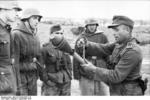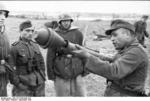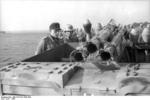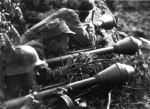Panzerfaust Launcher
| Country of Origin | Germany |
| Type | Launcher |
| Caliber | 149.000 mm |
| Capacity | 1 round |
| Length | 985.000 mm |
| Weight | 6.100 kg |
| Range | 60.000 m |
| Muzzle Velocity | 45 m/s |
Contributor: Alan Chanter
ww2dbasePanzerfaust was the brainchild of Dr. Heinrich Langweiler of the German armaments firm of Hugo Schneider AG of Leipzig (HASAG) in response to an urgent requirement for a light one-shot throw away infantry weapon with which infantry could tackle the growing numbers of Russian heavy and medium tanks that were frequently overwhelming German defences.In the early stages of the war, the standard infantry anti-tank gun was the 3.7-cm, Pak 35/36, a gun that although satisfactory against light vehicles, was soon found to be quite ineffective against the more heavily armoured tanks encountered as the war progressed. The 8.8-cm Raketenpanzerbuchse 43 Panzerschreck ("Tank Terror"), inspired by the American 3.5-inch bazooka, some of which had been captured in North Africa, went some way towards correcting the problem, although, like the Americans weapon, it suffered from a number of defects-it needed a two man crew, was bulky, unpleasant to fire, gave a significant back-blast, and was liable to misfire. What was really needed was an effective one-man weapon capable of disabling or destroying heavy tanks. It was to the great credit of the German designers that within six months they produced one, the Faustpatrone or ("Tank Fist") which, together with the bazooka, was probably the best remembered anti-tank weapon of the war.
Dr Langweiler's first experiments centred on a small hand-held hollow-charge bomb projector, but this required the user to be so close to the target that it did not develop beyond early consideration. His next design incorporated the simplest possible means of launching a hollow charge warhead without recoil, using the recoilless gun principle (rather than a rocket as some supposed). Known as the Panzerfaust 30 (Klein) it was dated from December 1942 and had a longer tube that fired a bomb with a diameter of 10.5-cm at an initial velocity of 30 metres per second. At the same time a larger version, the Panzerfaust 30 (Gross) was produced. This had a larger warhead of 15-cm diameter and would eventually become the most widely employed version. The launcher was just a piece of straight tubing 30 inches long (42 inches with the bomb in place) and 1.75 inches in diameter internally, with a crude rear sight spot welded to the top and a spring driven firing pin in a frame made by the sight hinge. Inside the tube was a paper case containing about six ounces of gunpowder; this being ignited by a percussion cap located on the outside of the tube firing through a hole in the tube leading to the propellant charge. .
The Panzerfaust's bomb weighed 6.75 pounds and was made of thin sheet steel with a wooden stem carrying the thin tail units and the fuse. The bomb was very roughly made and contained a hollow-charge warhead containing a three-pound seven ounce mixture of Cyclonite and TNT. The bomb was 19.5 inches long with its warhead nearly six inches in diameter. This gave a penetration of 200 millimeters-more than enough to defeat any tank of the day. The tail fins wrapped round the stem and the bomb was pushed into the tube and held in place with a pin. The Panzerfaust was issued to its user with the open end of the tube closed with a thin cap. The warhead, despite being powerful, was also quite sensitive, and the first production series of bombs was prone to explode on firing or by being dropped. Later models corrected this unhappy tendency, and reliability thereafter seemed to have been good.
To fire the Panzerfaust the infantryman simply had to raise the rear sight and cock the firing pin. He sighted over the widest part of the bomb, where a small stud formed a crude foresight, and fired by tripping the firing pin. After a loud bang and a flash, the bomb flew off, quite slowly. The infantryman would then throw the tube away. The range of the first Panzerfaust was only 30 metres, which made their use somewhat hazardous.
An improved 1944 model, using a larger propellant charge and a stronger tube, would increase the range to 60 metres and, late in November 1944, another model pushed the range to 100 metres. Both types were manufactured concurrently. A final model, produced in early 1945, was designed to fire up to ten bombs before being thrown away. This model had ten percussion caps in a row and successive bombs and propellant charges could be loaded from the front.
Panzerfäuste were made in very large numbers and widely issued. In the hands of a determined man it would pose a real threat to allied tanks and as the war drew to its conclusion whole units of virtually untrained Volkssturm were equipped with it and nothing else, in a last ditch attempt to halt the Allied tanks pushing into the Reich. ww2dbase
Last Major Revision: May 2011
Photographs
 |  |  |  |
Did you enjoy this article or find this article helpful? If so, please consider supporting us on Patreon. Even $1 per month will go a long way! Thank you. Share this article with your friends: Stay updated with WW2DB: |
Search WW2DB
News
- » WW2DB's 19th Anniversary (29 Dec 2023)
- » Looted Painting "Madonna with Child" Returned to Poland (2 Jun 2023)
- » Wreck of USS Mannert L. Abele Found (29 May 2023)
- » Wreck of Montevideo Maru Found (25 Apr 2023)
- » Accidental Detonation of a WW2-Era Bomb in Great Yarmouth (10 Feb 2023)
- » See all news
Current Site Statistics
- » 1,146 biographies
- » 336 events
- » 43,422 timeline entries
- » 1,237 ships
- » 349 aircraft models
- » 207 vehicle models
- » 372 weapon models
- » 123 historical documents
- » 259 facilities
- » 468 book reviews
- » 28,395 photos
- » 432 maps
Famous WW2 Quote
"I have returned. By the grace of Almighty God, our forces stand again on Philippine soil."General Douglas MacArthur at Leyte, 17 Oct 1944
Support Us
Please consider supporting us on Patreon. Even $1 a month will go a long way. Thank you!
Or, please support us by purchasing some WW2DB merchandise at TeeSpring, Thank you!